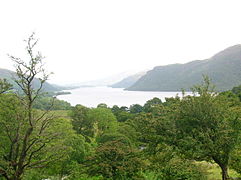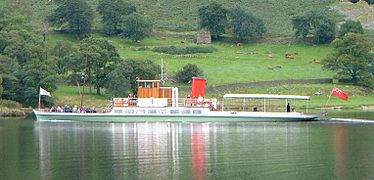Ullswater
| Ullswater | |
|---|---|
| Location | Lake District, England |
| Coordinates | 54°34′39″N 2°52′30″W / 54.5775°N 2.8751°W |
| Type | ribbon lake |
| Basin countries | United Kingdom |
| Max. length | 11.8 km (7.3 mi)[1] |
| Max. width | 1.02 km (0.63 mi)[1] |
| Surface area | 8.9 km2 (3.4 sq mi)[1] |
| Average depth | 25.3 m (83 ft)[1] |
| Max. depth | 63 m (207 ft)[1] |
| Water volume | 223 x 106 m³[1] |
| Residence time | 350 days[1] |
| Surface elevation | 145 m (476 ft) |
| Settlements | Glenridding, Pooley Bridge |
| References | [1] |

Ullswater is the second largest lake in the English Lake District, being approximately nine miles (14.5 kilometres) long and 0.75 miles (1,200 m) wide with a maximum depth of slightly more than 60 metres (197 ft). Many regard Ullswater as the most beautiful of the English lakes:[2] it has been compared to Lake Lucerne in Switzerland. It is a typical Lake District narrow "ribbon lake" formed after the last ice age when a glacier scooped out the valley floor and when the glacier retreated, the deepened section filled with meltwater which became a lake. A total of three separate glaciers formed the lake. The surrounding mountains give Ullswater the shape of a stretched 'Z' with three distinct segments (or 'reaches') that wend their way through the surrounding hills.
For much of its length Ullswater forms the border between the ancient counties of Cumberland and Westmorland.
The village of Glenridding, situated at the southern end of the lake, is popular with tourists of all kinds but especially with mountain walkers, who can scale England's third highest mountain, Helvellyn, and many other challenging peaks from there. The village has ample accommodation including two Youth Hostels and camp sites. The village of Pooley Bridge is at the northern extremity of the lake. Its narrow 16th-century bridge straddles the River Eamont as it flows out of Ullswater; it is overlooked by Dunmallard Hill, which was the site of an Iron Age fort. On the western side of the lake near Aira force waterfall lies numerous excellent accommodation sites including the Brackenrigg Inn which overlooks sweeping views of the dramatic landscape.
Etymology
The origin of the name 'Ullswater' is uncertain. Whaley suggests " 'Ulf's lake', from Old Norse pers.[onal] n.[ame] 'Ulfr' plus Middle English 'water' influenced in usage by Old Norse 'vatn' 'water', 'lake' ....'Ulfr' is also the Old Norse noun meaning 'wolf', and Hutchinson thought that the name might refer to the lake as a resort of wolves, or...to its elbow-shaped bend (citing a Celtic 'ulle'...)"[3]
Some say it comes from the name of a Nordic chief 'Ulf' who ruled over the area;[4] there was also a Saxon Lord of Greystoke called 'Ulphus' whose land bordered the lake. The lake may have been named Ulf's Water in honour of either of these, or it may be named after the Norse god Ullr. Hodgson Hill, an earthwork on the northeast shoreline of Ullswater may be the remains of a Viking fortified settlement.[5]
Sport and leisure
Ullswater's attractions include the Ullswater 'Steamers' which offer trips around the lake calling at Pooley Bridge, Glenridding and Howtown. The 'Steamers' operate all year round and were originally working boats which from the 1850s moved mail, workers and goods to and from the Greenside lead mine at Glenridding, which closed in 1962. Today there are five 'Steamers' plying the waters of Ullswater: 'Raven', 'Lady of the Lake', 'Lady Dorothy', Lady Wakefield, and, since 2010, 'Western Belle'. All the boats are now powered by diesel, with the two oldest, Lady of the Lake and Raven, having been converted from steam in the 1930s. People often catch the 'Steamer' from Glenridding to Howtown and then return on foot along the lake shore to complete one of the most popular and scenic low-level walks in the Lake District.Ullswater is home to Ullswater Yacht Club and the prestigious Lord Birkett Memorial Trophy, which is held annually on the first weekend in July. This regularly attracts upwards of 200 sailing boats and comprises 2 races, both of which cover the full length of the lake.
Ullswater is very popular as a sailing location, with sailing marinas situated around the lake. At weekends especially, the lake is dotted with many yachts but there are facilities also for diving, rowing and motorboats. Another of Ullswater's attractions is the spectacular waterfall of Aira Force midway along the lake on the western side. (Ullswater lies partly within the National Trust's Ullswater and Aira Force property.) Close to the falls is Lyulph's Tower, a pele tower or castellated building built by a former Duke of Norfolk as a shooting box.
Donald Campbell set the world water speed record on Ullswater on July 23, 1955, when he piloted the jet-propelled hydroplane "Bluebird K7" to a speed of 202.32 mph (325.53 km/h).
Notable people
Just south of Pooley Bridge on the lake's eastern shore is Eusemere, where anti-slavery campaigner Thomas Clarkson (1760–1846) lived; the house gives one of the best views of the lower reach of Ullswater. William and Dorothy Wordsworth were friends of Clarkson and visited on many occasions. After visiting Clarkson in April 1802, Wordsworth was inspired to write the poem "Daffodils" after seeing daffodils growing on the shores of Ullswater on his journey back to Grasmere. Wordsworth once wrote of "Ullswater, as being, perhaps, upon the whole, the happiest combination of beauty and grandeur, which any of the Lakes affords".[6]
The diplomat Sir Cecil Spring-Rice lived on the shore of Ullswater for a number of years, at Watermillock, and there are several memorials erected at nearby Aira Force to members of the Spring family.[7]
Gallery
-
Ullswater from Seldom Seen in Glencoynedale.
-
Ullswater steamer SS Lady On the Lake leaves Glenridding
-
Overlooking Ullswater from the north.
References
- ^ a b c d e f g h McNamara, Jane, Table of lake facts, Environment Agency of England and Wales, retrieved 2007-11-13 [dead link]
- ^ www.ullswater.visitor-centre.co.uk. Calls Ullswater "England's most beautiful lake and so much more".
- ^ Whaley, Diana (2006). A dictionary of Lake District place-names. Nottingham: English Place-Name Society. pp. lx, 423 p.351. ISBN 0904889726.
- ^ www.ullswater.visitor-centre.co.uk. Gives meaning of name as "Ulfs Water".
- ^ The Hodgson Clan Website
- ^ Wordsworth, William (1926). Wordsworth's Guide to the lakes (5th (1835), with an introduction, appendices, and notes textual and illustrative by Ernest de Selincourt ed.). London: Humphrey Milford. pp. xxxii, 203, p.14.
{{cite book}}: Cite has empty unknown parameter:|1=(help) - ^ http://www.visitcumbria.com/pen/aira-force/
External links
- Ullswater and Aira Force information at the National Trust
- Ullswater Yacht Club
- Ullswater 'Steamers'
- Lake District Desktops — Ullswater information and photographs.
- Ullswater Information, Photos and Events
- Lakeland Walks around Ullswater
- The Cumbria Directory - Ullswater
- Lake District Walks
- Lake District Walks - Ullswater Lake




